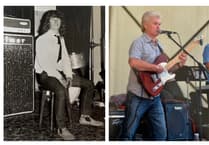When I think of Margam I get the mental picture of smutty ironworks, sooty houses covered by smog and pungent smells.
What a difference now as we visited Margam Park on a trip organised by Judith Scale for the Narberth Women's Union.
On a beautiful day on June 7, we boarded the coach hired from Clive Edwards, of Whitland, and ably driven by Lionel. Off we went, and once around Penblewin roundabout we settled down to enjoy the journey and beautiful view from our high vantage point in the coach. The sun shining as if it were high summer, the trees all decked out in their new green leaves, the cattle and sheep lazily grazing in the fields and the occasional rabbit sunning itself near the hedges, what more could one want?
In no time at all we arrived at our destination. Most of us made a beeline for the cafe and gift shop. Suitably sustained, the young at heart boarded the miniature train which took us on a short ride around the lakes and the parkland. What fun, we were transported back to our childhood, it was almost like a Sunday school trip to Tenby as we joked and waved to the children who were picnicking and playing in the wonderful grounds.
At two o'clock we embussed and were taken to the Abbey church. Edith and I took the opportunity to visit the Margam Stone Museum. In this building which once served as the school, the finest collection of early Christian sculptured and inscribed stones dating back to the sixth century were exhibited, the finest example being the Great Cross of Conbelin, an elaborate decorated disc-headed cross from the 10th century. The collection also included a number of grave slabs from the Medieval Cistercian Abbey.
By this time our bellies were beginning to grumble again and we were all entertained to a beautiful cream tea served in the Abbot's Kitchen. The tables were all prepared and laid out. Here one could eat as much as one wished, scones, cream, jam, and Welsh cakes and, best of all, plenty of tea just like mammy used to make.
Later we were invited to the Abbey where the chief verger, Mr. Malcolm Wills, welcomed us. He gave us a potted history of the Abbey, which was most interesting. He related that it dated back to the 12th century and was dedicated to St. Mary the Virgin.
In 1147, the Earl of Gloucester had granted the Cistercian monks all the land between the two rivers Afan and Kiffig. The Abbey was built on an earlier Christian site; this task took some 40 years to complete. However, in 1536, King Henry VIII closed the Abbey and the Monks were ejected. Sir Mansel Rice on behalf of the King took possession. He later purchased the Abbey and surrounding land. The estate was passed down to one Thomas Mansel Talbot who built the magnificent Oangery.
By late 1760s, the parishioners portioned Thomas to effect repairs. It had been described in 1787 as "in every way a very slovenly state, unpaved and without railings," finally the roof collapsed. Eventually Thomas agreed to part fund the restoration and work began in 1805. Much alteration was carried out. In 1830, Christopher Rice Mansel Talbot built the imposing Gothic Mansion, now known as the Margam Castle. An organ was installed in the Abbey for his daughter's wedding in 1866.
Malcolm Wills then conducted our party throughout the church describing the various statues and fittings. First we visited the Talbot Chapel which doubled as the vestry. Here we were shown the many vestments, which had been made by the ladies of the parish. In the south-east corner we found the Mansel Tombs; the elaborate carved marble effigies bear testimony to their vast wealth.
After a short break we joined an evening service conducted by Father Terry Doherty who only recently returned from his annual holiday in Rome. Edith and I would like to thank the ladies for a lovely day out and look forward to the next trip.
TOM



